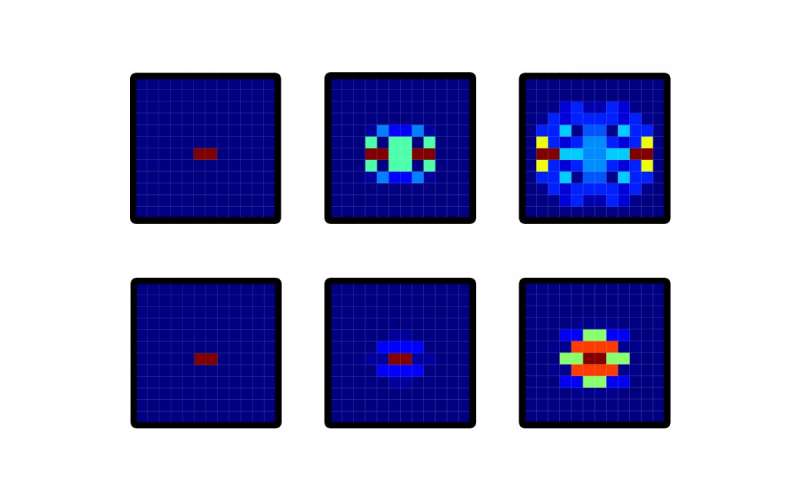Synthetic magnetism leads photons on a 2-D quantum walk

Randomness governs many things, from the growth of cell colonies and the agglomeration of polymers to the shapes of tendrils that form when you pour cream into a cup of coffee.
Since as early as 1905, scientists have described these seemingly unrelated phenomena in a unified way: as random walks. By imagining that individual particles or molecules are constantly taking steps in a random direction, researchers have successfully modeled many of the complexities of classical physics.
More recently, scientists have brought the idea of a random walk to the quantum world, where the "walkers" can exhibit nonclassical behaviors like quantum superposition and entanglement. These quantum random walks can simulate quantum systems and may eventually be used to implement speedy quantum computing algorithms. However, this will require the walker to move in multiple dimensions (2-D and higher), which has been difficult to achieve in a manner that is both practical and scalable.
Quantum walks that use photons—the quantum particles of light—are particularly promising, since photons can travel long distances as energy in wave form. However, photons don't carry an electric charge, which makes it difficult to fully control their motion. In particular, photons won't respond to magnetic fields—an important tool for manipulating other particles like atoms or electrons.
To address these shortcomings, researchers at the Joint Quantum Institute (JQI) have adopted a scalable method for orchestrating 2-D quantum random walks of photons—results that were recently published in the journal Physical Review Letters. The research team, led by JQI Fellows Edo Waks and Mohammad Hafezi, developed synthetic magnetic fields in this platform that interact with photons and affect the movement of photonic quantum walkers.
"Photonics provides a unique opportunity to study the behavior of poorly understood quantum systems," says Waks, who is also a member of the Institute for Research in Electronics and Applied Physics (IREAP) and a professor of physics and electrical and computer engineering at the University of Maryland. "The concepts behind this work could help researchers to explore new synthetic matter that does not yet exist but could have interesting properties and applications."
Previous studies of photonic quantum walks used complex optical networks to create actual pathways through space for quantum walkers to follow, splitting photons into left and right paths in a 1D quantum walk. But mimicking a higher-dimensional walk—in which photons can go up, down, left, right or beyond—is too cumbersome to implement with such systems.
To address this problem, the team adopted a simpler method for producing a photonic quantum walk. Instead of using complex optical setups to create actual pathways for the photons, they used fiber optic cables of varying lengths to simulate the different directions a photonic walker could potentially move. Since it takes photons more time to travel down a longer fiber, the travel times can encode the different directions a photon can take.
By directing photons down a random fiber and rerouting them back through the system again and again, the authors could simulate a quantum random walk using time delays instead of physical positions—a significant simplification compared to prior methods. By measuring the delays between photon pulses after each step, the researchers were able to determine how far the particles of light roamed from their initial location.
"The good thing with our platform is that it can be easily scaled to higher dimensions simply by using more fiber optic cables with different lengths," says Hamidreza Chalabi, a postdoctoral researcher at IREAP and the lead author of the study.
In their demonstration of a 2-D quantum random walk, the researchers created a synthetic magnetic field for the photons—something that may one day allow for more complex quantum walks or even simulations of arbitrary quantum systems. By modifying the wave nature of the photon pulses based on the direction they moved at each step, the team created an effective magnetic field on the walkers. The researchers then measured how far the walkers traveled from their initial locations and observed that they did not go as far as they did without the field—a suppression predicted by theory.
"This work is an important step toward more practical photonic-based quantum random walks," says Waks. "Exploring how these systems behave and how we can control them will allow us to perform more complex quantum simulations."
More information: Hamidreza Chalabi et al. Synthetic Gauge Field for Two-Dimensional Time-Multiplexed Quantum Random Walks, Physical Review Letters (2019). DOI: 10.1103/PhysRevLett.123.150503
Journal information: Physical Review Letters
Provided by Joint Quantum Institute


















